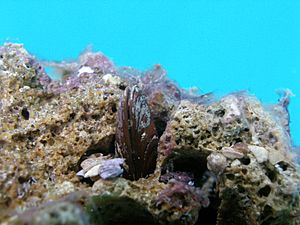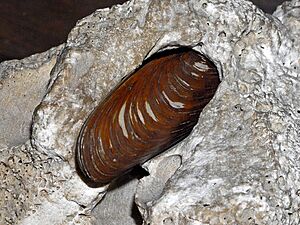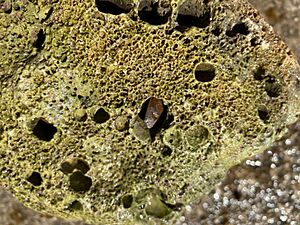Date shell facts for kids
Quick facts for kids Date shell |
|
|---|---|
 |
|
| Lithophaga lithophaga boring into marine rocks | |
| Conservation status | |
| Scientific classification | |
| Genus: |
Lithophaga
|
| Species: |
lithophaga
|
The date shell, or Lithophaga lithophaga, is a special type of bivalve. Bivalves are sea creatures with two shells, like clams or mussels. This particular shell belongs to the mussel family, Mytilidae.
Contents
Where Date Shells Live
Date shells can be found in the waters of the northeast Atlantic Ocean. They also live in the Mediterranean Sea and the Red Sea. Along the Adriatic Sea coast, especially in Croatia and Montenegro, people call them prstaci.
How Date Shells Live
These bivalves usually live where waves crash against the shore. But they can also be found much deeper, up to 125 to 200 meters underwater. Date shells are unique because they can drill into marine rocks. They create special holes called Gastrochaenolites to live in.
Date shells grow very slowly. It can take them 15 to 35 years to reach a length of just 5 centimeters (about 2 inches)! They eat tiny bits of food from the water. This includes plankton, algae, and other small particles. They filter these foods out of the water.
Date shells become ready to reproduce after about two years. A female date shell can release a huge number of eggs in one season. This can range from 120,000 to about 4.5 million eggs! The eggs are fertilized in the open water.
What Date Shells Look Like
The shells of Lithophaga lithophaga can grow to about 8.5 centimeters (about 3.3 inches) long. They are usually yellowish or brownish in color. Their shape is almost like a cylinder, rounded at both ends. Inside, the shell is a shiny, whitish-purple color with a hint of pink. These shells are quite thin. Their surface feels mostly smooth, but you can see lines where the shell has grown over time. Sometimes, these growth lines can feel a bit rough.
The Name's Meaning
The name Lithophaga lithophaga comes from ancient Greek words. Lithos means "rock" or "stone." Phaga or phago means "eating" or "devouring." So, the name basically means "rock-eating" or "rock-devouring" because of how they bore into stones!
Date Shells and People
Historically, date shells have been seen as a special food. People often cooked them in a broth with white wine, garlic, and parsley. They were considered a delicious treat.
Protecting Date Shells
Collecting date shells can be very harmful to the environment. To get them, people often have to break apart the rocks where the shells live. This can damage the coast and even lead to desertification, where the land becomes barren.
Because of this damage, many governments have made it harder to collect these shells. Some countries have even made it completely illegal! These countries include Croatia, Italy, Slovenia, France, Greece, and Montenegro. Many countries that are part of the Convention on the Conservation of European Wildlife and Natural Habitats (also known as the Bern Convention) also protect date shells.
The date shell is also listed in Appendix II of the Convention on International Trade in Endangered Species. This means that trading these shells between countries is carefully controlled. It requires special permits to make sure they are not over-collected. As of 2004, the date shell populations along the coast of Turkey were not considered to be in danger.



